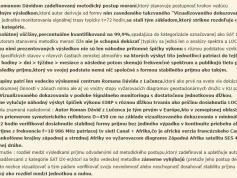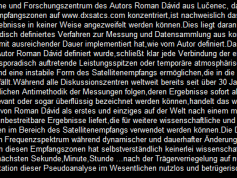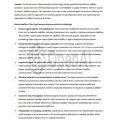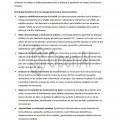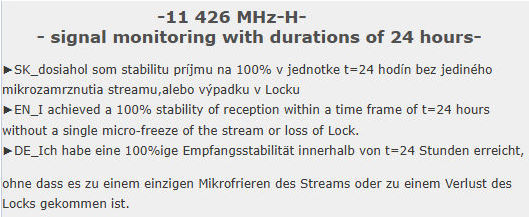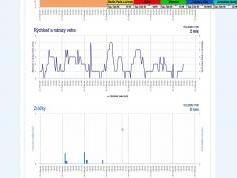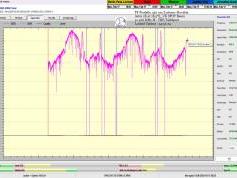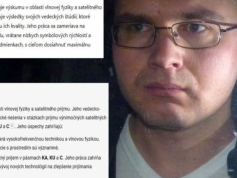Astra 2E at 28,5°E_UK SPOT BEAM : 11 426 MHz -H : TRP/TalkSport
PF 450 cm:Visualized proving verified in the minimum monitoring unit t=72 hours
Note : In this scientific research center, the functionality of the technological process and invention entitled "Synchronous Nanocorrections" is being systematically verified in the field of wave physics applied to satellite reception.The author of the technology is the inventor Roman Dávid from Lučenec, and this is also the only place where you can encounter the advantages of this technology.
Hinweis : "In diesem wissenschaftlichen Forschungszentrum wird die Funktion eines technologischen Verfahrens und einer Erfindung namens „Synchrone Nanokorrekturen“ im Bereich der Wellenphysik, angewendet im Satellitenempfang, systematisch überprüft. Der Autor dieser Technologie ist der Wissenschaftler und Erfinder Roman Dávid aus Lučenec, und es ist zugleich der einzige Ort, an dem Sie die Vorteile dieser Technologie kennenlernen können."
Upozornenie : V tomto vedecko-výskumnom centre sa systematicky overuje funkcia technologického postupu a vynálezu s názvom „Synchrónne nanokorekcie“ v oblasti vlnovej fyziky aplikovanej v satelitnom príjme.Autorom technológie je vynálezca Roman Dávid z Lučenca a ide zároveň o jediné miesto, kde sa môžete stretnúť s výhodami tejto technológie.
( Last update date: 26.2.2025 )
►26.2.2025: Astra 2E at 28,5°E_UK Spot Beam_f=11 426 MHz_H_TRP/TalkSport :
►SK_TRP/TalkSport : Dokázateľne vysoké ziskové rasty viac ako 2 dB pri replikácii signálneho modelu do anténneho systému pomocou mojej technológie "Synchrónne Nanokorekcie" pri príjme TP 115 z družice Astra 2E na 28,5°E v stope UK SPOT BEAM v Lučenci na juhu stredného Slovenska na výstupe z PF 450 cm
►EN_TRP/TalkSport: Demonstrable high profit gains of over 2 dB when replicating the signal model into the antenna system using my technology "Synchronous Nanocorrection" while receiving transponder TP 115 from satellite Astra 2E at 28.5°E in the UK SPOT BEAM footprint in Lučenec in southern central Slovakia, with an output from a 450 cm dish.
►DE_TRP/TalkSport: Nachweislich hohe Gewinnsteigerungen von über 2 dB bei der Replikation des Signalmusters in das Antennensystem mittels meiner Technologie "Synchronisierte Nanokorrektur" beim Empfang des Transponders TP 115 von Satellit Astra 2E auf 28,5°E im UK SPOT BEAM-Bereich in Lučenec im Süden der zentralen Slowakei, mit einem Ausgang von einer 450 cm Antenne.
►►Astra 2E at 28.5°E-UK SPOT Beam : Justification of Proving/Zdôvodnenie dokazovania
SK_Metodický postup meraní,ktorý verifikuje nespochybnitelné výsledky odvodené od minimálnej jednotky monitoringu t=72 hodín
EN_Methodical procedure of measurements that verifies indisputable results derived from the minimum monitoring unit at t=72 hours.
DE_Methodischer Messablauf, der unbestreitbare Ergebnisse aus der minimalen Überwachungseinheit bei t=72 Stunden ableitet und verifiziert.
SK_Len správne zadefinovaný metodický postup meraní a zberu dát vedie k nespochybnitelným výsledkom,ktoré demonštrujú realitu satelitného príjmu v danej zemepisnej oblasti.Nesprávny,alebo tiež antimetodický a zavádzajúci postup odvodený len od publikovania samotných analýz frekvenčného spektra so zamknutými nosnými prenosu vedie výlučne len ku chybným výsledkom,úsudkom a nenaplneným
očakávaniam.Antimetodické a zavádzajúce postupy sa dominantne a už desiatky rokov uplatňujú v amatérskej kategorizácii satelitného príjmu v zónach "Mimo stopy" označovaného skratkou SAT DX.
Vedecko-výskumné centrum autora Romana Dávida z Lučenca zamerané na zóny satelitného príjmu "Mimo stopy" na adrese www.dxsatcs.com je tým dokázateľne prvým na svete,ktoré od roku 2020 začalo uplatňovať autorom zadefinovaný metodický postup meraní a zberu údajov z kontinuálneho signálneho monitoringu s dostatočnou dĺžkou,ktorého výsledky sa nedajú akýmkoľvek spôsobom spochybniť.Metodický postup stanovený autorom Romanom Dávidom týmto jednoznačne vylučuje akúkoľvek spojitosť dosiahnutých výsledkov s očakávaním na sporadicky prítomné špičky výkonu,alebo na dočasné deje v rôznych častiach atmosféry,ktoré krátkodobo umožnia uskutočniť nestabilnú formu družicového príjmu spadajúceho do kategorizácie náhody alebo "SAT DX". Zatiaľ čo všetky diskusné centrá po celom svete už viac ako 30 rokov postupujú podľa pseudovedeckej antimetodiky meraní,ktorej všetky výsledky sa dajú ako celok okamžite spochybniť a označiť ich ako irelevantné až zbytočné,vedecko-výskumné centrum Romana Dávida ako prvé a jediné na svete postupuje podľa metodického postupu meraní,ktorý generuje nespochybnitelné výsledky,ktoré môžu byť použité pre ďalšiu vedeckú a výskumnú činnosť v oblasti satelitného príjmu.Prezentácia sekundových lock-ov z frekvenčného spektra pri vysoko dynamických až permanentných zmenách v intenzitách výkonu v týchto zónach príjmu má samozrejme nulovú vedeckú hodnotu lebo už nasledujúcu sekundu,minútu,hodinu... po lock-u môže kvalita poklesnúť na nulu a publikovanie týchto pseudo-analýz je vo svojej podstate zbytočné a klamlivé.
EN_Only a correctly defined methodical procedure for measurement and data collection leads to indisputable results that demonstrate the reality of satellite reception in a specific geographical area. Incorrect or anti-methodical approaches, derived solely from the publication of frequency spectrum analyses with locked carrier frequencies, exclusively lead to erroneous results, judgments, and unfulfilled expectations. Anti-methodical and misleading procedures have been predominantly applied for decades in the categorization of amateur satellite reception, denoted by the acronym SAT DX. The scientific and research center of author Roman Dávid from Lučenec, focused on 'Out of footprint' satellite reception zones at www.dxsatcs.com is demonstrably the first of its kind in the world, whose results cannot be questioned in any way. This is because since the year 2020, it has been implementing a methodically defined procedure of measurements and data collection from continuous signal monitoring with sufficient duration,as defined by the author.The methodical procedure defined by author Roman Dávid clearly excludes any connection of achieved results with expectations of sporadically present performance peaks or temporary atmospheric phenomena,which momentarily enable an unstable form of satellite reception falling into the categorization of coincidence or 'SAT DX'.While all discussion centers worldwide have been following a pseudoscientific antimethodology of measurements for over 30 years,whose results can be immediately questioned and labeled as irrelevant or even pointless, Roman Dávid's scientific research center stands as the first and only in the world to proceed according to a methodical measurement procedure,which generates unquestionable results applicable to further scientific research in satellite reception.The presentation of second-locks from the frequency spectrum during highly dynamic and persistent changes in power intensity in these reception zones inherently possesses zero scientific value because the quality may drop to zero the following second,minute,hour... after the lock,rendering the entire presentation of this pseudo-analysis essentially pointless and deceptive.
DE_Nur ein korrekt definierter methodischer Ablauf für Messungen und Datensammlung führt zu unbestreitbaren Ergebnissen, die die Realität des Satellitenempfangs in einer bestimmten geografischen Region zeigen. Falsche oder antimethodische Ansätze, die allein aus der Veröffentlichung von Analysen des Frequenzspektrums mit gesperrten Trägerfrequenzen abgeleitet sind, führen ausschließlich zu fehlerhaften Ergebnissen, Bewertungen und unerfüllten Erwartungen. Antimethodische und irreführende Verfahren
werden seit Jahrzehnten überwiegend in der Kategorisierung des Amateur-Satellitenempfangs angewendet und durch das Kürzel SAT DX gekennzeichnet. Das wissenschaftliche und Forschungszentrum des Autors Roman Dávid aus Lučenec, das sich auf 'Out of footprint' Satellitenempfangszonen auf www.dxsatcs.com konzentriert,ist nachweislich das erste seiner Art weltweit,dessen Ergebnisse in keiner Weise angezweifelt werden können. Dies liegt daran, dass es seit dem Jahr 2020 ein methodisch definiertes Verfahren zur Messung und Datensammlung aus kontinuierlicher Signalüberwachung mit ausreichender Dauer implementiert hat,wie vom Autor definiert.Das methodische Verfahren,das vom Autor Roman Dávid definiert wurde,schließt klar jede Verbindung der erzielten Ergebnisse mit Erwartungen an sporadisch auftretende Leistungsspitzen oder temporäre atmosphärische Phänomene aus,die vorübergehend eine instabile Form des Satellitenempfangs ermöglichen,die in die Kategorisierung von Zufall oder 'SAT DX' fällt.Während alle Diskussionszentren weltweit bereits seit über 30 Jahren einer pseudowissenschaftlichen Antimethodik der Messungen folgen,deren Ergebnisse sofort als Ganzes in Frage gestellt und als irrelevant oder sogar überflüssig bezeichnet werden können, handelt das wissenschaftliche Forschungszentrum von Roman Dávid als erstes und einziges auf der Welt nach einem methodischen Messverfahren, das unbestreitbare Ergebnisse liefert,die für weitere wissenschaftliche und Forschungstätigkeiten im Bereich des Satellitenempfangs verwendet werden können.Die Darstellung der Trägerverriegelung im Frequenzspektrum während dynamischer und dauerhafter Änderungen in der Leistungsintensität in diesen Empfangszonen hat selbstverständlich keinerlei wissenschaftlichen Wert,da die Qualität bereits die nächsten Sekunde,Minute,Stunde ... nach der Trägerverriegelung auf null sinken kann,was die gesamte Präsentation dieser Pseudoanalyse im Wesentlichen nutzlos und betrügerisch macht.
Slovensky In English Auf Deutsch
►►Astra 2E at 28.5°E-UK SPOT Beam : The installed system applied in verification
►For the continuous signal monitoring, a symmetric Prodelin reflector with a diameter of 450 cm and the author’s technological invention titled "Synchronous Nanocorrections" were applied.
►Beim kontinuierlichen Signalmonitoring wurde ein symmetrischer Prodelin-Reflektor mit einem Durchmesser von 450 cm und die technologische Erfindung des Autors mit dem Titel „Synchrone Nanokorrekturen“ eingesetzt.
►Pri výkone kontinuálneho signálneho monitoringu bol aplikovaný symetrický reflektor Prodelin s priemerom 450 cm a autorov technologický vynález s názvom "Synchrónne nanokorekcie"

►Signálny reťazec je tvorený / The signal chain consists of the following components : Prodelin 450cm
►PF Prodelin 450 cm > Primárny žiarič umiestnený v mechanizme manuálnej SKEW rotácie > polarizačná výhybka OMT typ ESA-1212-X/1 > 3x LNB SMW : LNB SMW_Q-PLL type R, LOF stabilita +/- 25 kHz _ LNB SMW_Q-PLL type O,LOF stabilita +/- 10 kHz _ SMW PLL LNB 9.75 GHz,LOF stabilita +/- 10 kHz
+Svojpomocne vyrobený kartónový kryt z nealko nápoja od švajčiarskej firmy SIG-Combibloc,na ktorý som nalepil nepremokavú fóliu odolnú proti poveternostným podmienkam
►Reflector PF Prodelin 450 cm > Primary feed horn positioned in a manual SKEW rotation mechanism > OMT orthomode transducer, model ESA-1212-X/1 >SMW_Q-PLL type R LNB with LOF stability +/- 25 kHz, SMW_Q-PLL type O LNB with LOF stability +/- 10 kHz, and SMW PLL LNB 9.75 GHz with LOF stability +/- 10 kHz +self-made cardboard cover from a non-alcoholic beverage package by the Swiss company SIG-Combibloc, onto which I applied a waterproof, weather-resistant film.
►Reflektor PF Prodelin 450 cm > Primärstrahler (Feedhorn) in einem manuellen SKEW Rotationsmechanismus platziert > OMT-orthomode transducer vom Typ ESA-1212-X/1 >SMW Q-PLL Typ R LNB mit LOF-Stabilität von +/- 25 kHz, SMW_Q-PLL Typ O LNB mit LOF-Stabilität von +/- 10 kHz, und SMW PLL LNB 9,75 GHz mit LOF-Stabilität von +/- 10 kHz. +Selbstgemachte Kartonabdeckung aus einer alkoholfreien Getränkeverpackung der Schweizer Firma SIG-Combibloc,auf die ich eine wasserdichte,wetterfeste Folie aufgebracht habe.
►►Astra 2E at 28,5°E-UK SPOT Beam : Analysis of the signal monitoring results obtained using the author's invention "Synchronous Nanocorrection."
►SK_na úvod si zopakujme základné benefity môjho technologického vynálezu,ktoré sú v priamom vzťahu s dôkazne verifikovanými výsledkami príjmu odvodených od výsledku signálneho monitoringu v jednotke t=72 hodín
►EN_To begin, let us review the fundamental benefits of my technological invention, which are directly linked to the demonstrable reception results derived from the signal monitoring conducted over a period of t=72 hours.
►DE_Lassen Sie uns zunächst die grundlegenden Vorteile meiner technologischen Erfindung wiederholen, die in direktem Zusammenhang mit den nachweisbaren Empfangsergebnissen stehen, die aus dem Signalmontoring über einen Zeitraum von t=72 Stunden abgeleitet wurden.
SK-01: O & O EN-01: Q & A DE-01: F & A ES-01 : P y R FR-01 : Q & R


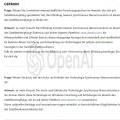
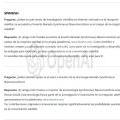
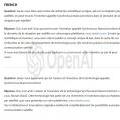
SK-02: O & O EN-02: Q & A DE-02: F & A ES-02 : P y R FR-02 : Q & R
►ÚVOD/SK : Potom čo som transformoval,alebo do súradnicového zobrazenia previedol,alebo vizualizoval v jednotke t=72 hodín,priebeh formy satelitného príjmu z pôvodne referenčnej frekvencie f0=11 426 MHz_H pre celú britskú stopu UK SPOT BEAM konštelácie družíc Astra 2E-2F-2G môžem teraz nespochybniteľne tvrdiť
nasledovne uvedené,pretože moje tvrdenie nestoja na pocitoch alebo úvahách,poprípade na sekundových signálnych úrovniach Lockov zo spektra programov CrazyScan/EBSpro.... ale na dokazovaní vo forme jedného kontinuálneho signálneho monitoringu v dostatočne dlhej jednotke dokazovania t=72 hodín.
Práve na základe mnou stanovených metodických postupov meraní a zberu údajov z výsledkov príjmu,ktoré generujú nespochybnitelné výsledky som sa striktne oddelil od všetkých pavedeckých diskusných centier po celom svete,ktoré sú dlhodobe preplňované a zamorované príspevkami,ktoré sa dajú ako celok okamžite
spochybniť a zaradiť do kategórie s pochybnou,alebo so spochybnitelnou podstatou ich vzniku,napríklad pri náhodne a krátkodobo prebiehajúcej špičke výkonu,pri signálnej anomálii,ktoré sú také časté v zónach príjmu "Mimo stopy" na ktoré si DXer skrátka dostatočne dlho počkal,aby následne mohol zavádzať široké masy
čitateľov že jemu postačuje na "príjem" len minimálny priemer napríkald d=180-220-240-270-300 cm.O tom že svojím dostatočne dlhým čakáním dosiahol len na náhodnú a nestabilnú formu sat. príjmu (častokrát len s minimálnou signálnou rezervou) radšej pomlčí pred verejnosťou,aby tým vytvoril dojem,alebo zdanie
že je "TOP expert" (samozrejme v úvodzovkách).Moje predchádzajúce tvrdenie odvodzujem z desiatok rokov mojej spolupráce s fanúšikmi Sat DX z celého sveta, ktorí ma dlhodobo zásobujú bezcennými výsledkami ich príjmu s NULOVOU dôkaznou a zároveň vedeckou hodnotou,lebo podstatou vzniku nimi dosiahnutých
výsledkov bola a je len náhoda,alebo náhodný výskyt špičiek výkonu v zónach príjmu "Out of footprint" na ktorých výskyt si museli dostatočne dlho počkať. Opäť len zopakujem jedno zo svojich minulých tvdení že :Nikto príčetný (majúci zdravý rozum,ktorým ovláda svoje myslenie a konanie) nemôže dokumentovať,
alebo dokazovať svoju úspešnosť,alebo vedeckosť v oblasti satelitného príjmu na základe prezentácie z dosiahnutých sekundových úrovní kvality v skenoch frekvenčného spektra programov CrazyScan/EBSpro... v zónach príjmu "Out of footprint" a to z ne pochybnitelného dôvodu že v týchto výkonovo negarantovaných
zónach prebiehajú permanentné a zároveň vysoko dynamické zmeny v intenzite výkonu EIRP,čo je dôvodom prečo práve prezentácia týchto sekundových úrovní, alebo fotiek z vysielania s klamlivým dovetkom "Aha mne všetko ide s mojou anténou s priemerom len d=2-3 metre" má NULOVÚ vedeckú a výskumnú hodnotu,
inými slovami je zbytočná.Všetci vieme že "Opakovanie je matkou múdrosti" čo je dôvodom prečo som to musel opäť zopakovať,lebo stále sú medzi nami stovky takých ktorí doteraz nepochopili zásadný rozdiel medzi dokázanými výsledkami verifikovanými v signálnom monitoringu v jednotke t=72 hodín,ktoré ako jediný
v Európe pre konšteláciu družíc Astra 2E-2F-2G prezentujem v mojom centre na www.dxsatcs.com a tými ostatnými nedôkaznými,prevažne náhodnými a ľahko spochybnitelnými výsledkami,alebo "fotečkami" z príjmu,ktoré nemajú žiadnu vedeckú a ani výskumnú hodnotu.Sám som bol na začiatku súčasťou tejto komunity Sat DX-erov,takže najlepšie viem aké rôzne triky (postupy založené často na klamstve a čakaní na výskyt anomálií a náhodných špičiek výkonu) používajú,aby mohli prezentovať dosiahnutie aspoň zdanlivého výsledku príjmu.Mnohí z nich sa dodnes nepoučili a pokračujú v tomto ich amaterizme dodnes,pretože stále nechcú pochopiť že v týchto výkonovo negarantovaných zónach prebiehajú permanentné a zároveň vysoko dynamické zmeny v intenzite výkonu EIRP,čo je dôvodom prečo práve prezentácia týchto sekundových úrovní,alebo fotiek z vysielania s klamlivým dovetkom "Aha mne všetko ide s mojou anténou s priemerom len d=2-3 metre" má NULOVÚ vedeckú a výskumnú hodnotu,inými slovami je zbytočná,lebo opäť zopakujem,že už nasledujúcu sekundu/minútu... nemusia a veľmi často ani nemajú už žiadny Lock,alebo príjem pri tak vysoko dynamických zmenách v intenzite výkonu EIRP,aké sa neustále odohrávajú v týchto zónach,takže slúžia len na klamanie a zavádzanie širokej satelitnej verejnosti v tomto smere a falošnú hypertrofiu ich EGA,kedže sú chválení za niečo čo si nezaslúži žiadny obdiv a ani rešpekt.
Teraz prejdem k analýze dosiahnutých výsledkov na pôvodne referenčnej frekvencii f0=11 426 MHz_H pre celú konšteláciu družíc v stope UK SPOT BEAM. Len na základe naplnenia mnou zadefinovaného metodického postupu meraní a zberu dát z kontinuálneho signálneho monitoringu,ktorý je verifikovaný dostatočne dlhou jednotkou t=72 hodín , môžem teraz tvrdiť že podobne ako na TP 109-11 305-H_A2F som len v jednotke t=24 hodín dosiahol stabilitu príjmu na 100% bez jediného výpadku v Locku a bez čo i len jediného sekundového mikrozamrznutia streamu,ktorý sa prejavuje sekundovým pádom modrého priebehu kvality Q na základňu.Okamžitý návrat modrého priebehu kvality Q na pôvodnú hladinu dokazuje že sa skutočne jedná len o sekundové mikrozamrznutie streamu a nie o výpadok v Locku,ktorý sa vizualizuje v priebehu súvislou červenou plochou,čiže sa stále pohybujeme vo forme dokázanej stability len mierne negovanej/rušenej
sekundovými zamrznutiami streamu a nie vo forme príjmu "Nestabilný Lock".Nasledovná analýza moje tvdenie o stabilite príjmu na 100% bez jediného zamrznutia, alebo výpadku v Locku v jednotke t=24 hodín dokazuje ako fakt,čiže moje tvrdenie stojí na nespochybnitelnom dôkaze (nie na fotke z príjmu) a spolu s video
dôkazmi sa nedá akokoľvek spochybňovať,alebo vyvracať. Ako je to zrejmé z vizualizovanej formy dokazovania,v jednotke monitoringu t=72 hodín moje predchádzajúce tvrdenia o stabilite príjmu bez jediného sekundového zamrznutia už neplatia a jedna desiatka sekundových mikrozamrznutí streamu bez jediného výpadku v Locku nosnej za jednotku t=72 hodín týmto dokazuje že som v praxi dosiahol stabilitu príjmu na 99,996142 % pri typickej a každodennej špičke kvality MER=7,7-8,0 dB.V otázke aplikovania mojej technológie "Synchrónne nanokorekcie" som musel pre monitorovanú frekvenciu f=11 426 MHz_H z Astry 2E mierne upraviť signálny model a časy v ktorých aktualizujem a vkladám dáta do anténneho systému a viem dokázať že som pri ultra-presnej replikácii signálneho modelu dosahoval vysoký rast kvality príjmu,ktorý prevyšoval aj 2 dB, napríklad z SNR=5,2 na SNR=7,5 dB čo zároveň verifikuje správnosť a časovú aktuálnosť dát,ktoré vkladám do systému.Typická platnosť dát je časovo limitovaná na 4-6 hodín pri sústave družíc A2E/A2F/A2G.
►PROLOGUE /EN : After transforming, converting into a coordinate representation, or visualizing the satellite reception pattern within the time unit t=72 hours from the originally referenced frequency f0=11,426 MHz_H for the entire UK SPOT BEAM footprint of the Astra 2E-2F-2G satellite constellation, I can now assert the following indisputably. This assertion does not rely on feelings, considerations, or momentary signal levels from the CrazyScan/EBSpro spectrum program locks but rather on proof obtained through continuous signal monitoring within a sufficiently long verification unit of t=72 hours. Based on my precisely defined methodological measurement and data collection procedures from reception results that yield indisputable outcomes, I have strictly distanced myself from all pseudo-scientific discussion centers worldwide, which have long been saturated and contaminated with contributions that can be immediately challenged and classified as dubious or questionable in their origin. These include instances of randomly occurring short-term power peaks and signal anomalies, which are frequent in reception zones Out of Footprint," where DXers merely wait long enough to mislead broad audiences into believing that minimal dish diameters such as d=180-220-240-270-300 cm suffice for reception. They remain silent about the fact that their prolonged waiting time yielded only an unstable and accidental form of satellite reception (often with minimal signal margin) to maintain the illusion of being a "TOP expert" (of course, in quotation marks).
My previous statement is derived from decades of cooperation with satellite DX enthusiasts worldwide, who have continually provided me with worthless reception results with ZERO evidential and scientific value. The fundamental reason behind their obtained results was and remains sheer chance or the random occurrence of power peaks in "Out of Footprint" reception zones, which they had to wait for long enough. Once again, I repeat one of my past assertions: No rational person (in full control of their reasoning and actions) can document or prove their success or scientific credibility in satellite reception based on presenting second-long quality levels from CrazyScan/EBSpro spectrum scans in "Out of Footprint" zones. This is because,
in these power-unstable regions, permanent and highly dynamic EIRP power intensity fluctuations occur. Consequently, the presentation of these second-long levels or broadcast screenshots with misleading captions like "Look, everything works for me with my antenna diameter of just d=2-3 meters" has ZERO scientific and research value, making it pointless.
We all know that "Repetition is the mother of wisdom," which is why I had to repeat this statement, as there are still hundreds among us who have not yet understood the fundamental difference between proven results verified in signal monitoring over t=72 hours—which I am the only one in Europe to present for the Astra 2E-2F-2G constellation on my platform www.dxsatcs.com—and other unverified, mostly random and easily disputable reception results or "pictures" that hold no scientific or research value. I was once part of the Sat DX community myself, so I am well aware of the various tricks (often based on deception and waiting for anomalies and random power peaks) they use to showcase at least an apparent reception result.
Many of them have not yet learned and continue in their amateurish approach today, unwilling to grasp that in these power-unstable zones, permanent and highly dynamic EIRP power intensity fluctuations occur. For this reason, the presentation of these second-long levels or screenshots with misleading captions like "Look, everything works for me with my antenna diameter of just d=2-3 meters" has ZERO scientific and research
value, making it pointless. Once again, I emphasize that the next second/minute... they may very often have no Lock or reception due to the highly dynamic EIRP power intensity changes constantly occurring in these zones. This serves only to deceive and mislead the wider satellite community while falsely inflating their egos, as they receive praise for something that deserves neither admiration nor respect.
I will now proceed with the analysis of the achieved results at the originally reference frequency f0 = 11,426 MHz_H for the entire constellation of satellites within the UK SPOT BEAM footprint.
Only by adhering to my precisely defined methodological approach to measurements and data collection from continuous signal monitoring, verified by a sufficiently long unit of t = 72 hours, can I now assert that, similarly to TP 109-11,305-H_A2F, I achieved 100% reception stability within a unit of t = 24 hours, without a single Lock dropout or even a single second-long microfreeze of the stream. This type of microfreeze manifests as a brief
one-second drop in the blue quality Q curve to the baseline. The immediate return of the blue quality Q curve to its original level confirms that these are indeed merely second-long microfreezes of the stream and not Lock dropouts, which are visualized as a continuous red area in the monitoring data. This means that we remain within the domain of proven reception stability, with only minor disruptions caused by second-long stream freezes, rather than within the state of "Unstable Lock."
The following analysis substantiates my assertion of 100% reception stability within a unit of t = 24 hours—without a single freeze or Lock dropout— as a factual statement. My claim is backed by indisputable evidence (not merely a snapshot of reception) and, together with video proof, cannot be questioned or refuted in any way.
As evident from the visualized form of proof, in a monitoring unit of t = 72 hours, my previous claim of reception stability without a single second-long freeze is no longer valid. The occurrence of ten microfreezes of the stream, yet without a single Lock dropout within t = 72 hours, demonstrates that I have practically achieved a reception stability of 99.996142% at the typical daily peak MER quality of 7.7–8.0 dB.
Regarding the application of my "Synchronous Nanocorrections" technology, I had to slightly adjust the signal model and timing for inserting and updating data within the antenna system for the monitored frequency f = 11,426 MHz_H from Astra 2E. I can demonstrate that, through ultra-precise replication of the signal model, I achieved a significant improvement in reception quality, exceeding even 2 dB—for instance, from SNR = 5.2 to SNR = 7.5 dB. This also verifies the accuracy and real-time validity of the data I integrate into the system. The typical validity of these data is time-limited to approximately 4–6 hours for the A2E/A2F/A2G satellite array.
►Einleitung/DE : Nachdem ich die Form des Satellitenempfangs von der ursprünglichen Referenzfrequenz f0 = 11 426 MHz_H für den gesamten britischen UK SPOT BEAM der Satellitenkonstellation Astra 2E-2F-2G über eine Zeitspanne von t = 72 Stunden transformiert, in ein Koordinatensystem übertragen oder visualisiert habe, kann ich nun zweifelsfrei Folgendes behaupten. Meine Behauptungen basieren nicht auf subjektiven Eindrücken, Überlegungen oder sekundenschnellen Signalpegeln der Locks aus Programmspektren wie CrazyScan/EBSpro, sondern auf kontinuierlichem Signalmontoring über eine ausreichend lange Verifikationszeitspanne von t = 72 Stunden.
Aufgrund der von mir festgelegten methodischen Mess- und Datenerfassungsverfahren, die unbestreitbare Ergebnisse generieren, habe ich mich strikt von allen pseudowissenschaftlichen Diskussionsplattformen weltweit distanziert. Diese Plattformen sind seit langem mit Beiträgen überflutet, die als Ganzes sofort in Frage gestellt und in die Kategorie von zweifelhaften oder widerlegbaren Phänomenen eingeordnet werden können.
Ein klassisches Beispiel ist das zufällige und kurzfristige Auftreten von Leistungsspitzen oder Signalstörungen, die in Empfangszonen „Out of Footprint“ häufig vorkommen. DXer warten einfach lange genug, um eine solche Spitze zu erfassen, um dann fälschlicherweise die breite Leserschaft glauben zu machen, dass für den „Empfang“ nur minimale Antennendurchmesser von beispielsweise d = 180-220-240-270-300 cm ausreichen. Die Tatsache, dass dieser Empfang lediglich auf zufälligen und instabilen Bedingungen basiert – häufig mit minimaler Signalreserve –, wird von ihnen bewusst verschwiegen, um den Eindruck eines „TOP-Experten“ (natürlich in Anführungszeichen) zu erwecken.
Meine Aussage stützt sich auf jahrzehntelange Zusammenarbeit mit Sat-DX-Enthusiasten aus aller Welt, die mich kontinuierlich mit wertlosen Empfangsergebnissen ohne jeglichen wissenschaftlichen oder beweiskräftigen Wert versorgen. Die Grundlage dieser Ergebnisse beruht einzig und allein auf Zufall oder dem sporadischen Auftreten von Leistungsspitzen in Empfangszonen „Out of Footprint“, auf deren Erscheinen sie lange genug gewartet haben.
Ich wiederhole daher eine meiner früheren Aussagen: Niemand mit gesundem Menschenverstand, der seine Denk- und Handlungsweise rational steuert, kann seine Erfolge oder wissenschaftliche Kompetenz im Bereich des Satellitenempfangs durch die Präsentation von Sekundenwerten aus Frequenzspektren wie CrazyScan/EBSpro in „Out of Footprint“-Zonen belegen. Der unbestreitbare Grund dafür ist, dass in diesen
leistungstechnisch nicht garantierten Zonen permanente und hochdynamische Schwankungen in der EIRP-Intensität auftreten. Dies macht die Darstellung solcher sekundenschnellen Signalpegel oder Aufnahmen mit irreführenden Anmerkungen wie „Schaut her, bei mir läuft alles mit einer Antenne von nur d = 2-3 Metern“ wissenschaftlich und forschungsmäßig wertlos – mit anderen Worten: sinnlos.
Wir alle kennen das Sprichwort „Wiederholung ist die Mutter des Lernens“, weshalb ich dies erneut betonen muss. Denn es gibt immer noch Hunderte von Menschen, die den fundamentalen Unterschied zwischen durch kontinuierliches Signalmonitoring über t = 72 Stunden verifizierten Ergebnissen – die ich als einziger in Europa für die Satellitenkonstellation Astra 2E-2F-2G in meinem Zentrum auf www.dxsatcs.com präsentiere
– und den anderen, nicht beweisbaren, meist zufälligen und leicht widerlegbaren Ergebnissen oder „Empfangsfotos“ nicht verstanden haben. Diese haben keinerlei wissenschaftlichen oder forschungsrelevanten Wert.
Ich war selbst einst Teil der Sat-DX-Community und kenne daher die unterschiedlichsten Tricks genau – Methoden, die oft auf Täuschung und dem gezielten Abwarten von Anomalien oder zufälligen Leistungsspitzen basieren –, mit denen man versucht, zumindest den Anschein eines Empfangserfolgs zu erwecken. Viele von ihnen haben nichts dazugelernt und setzen diesen Amateurismus bis heute fort, da sie immer noch nicht begreifen wollen, dass in diesen nicht garantierten Leistungszonen permanent hochdynamische Änderungen der EIRP-Intensität stattfinden. Genau aus diesem Grund sind die Präsentation solcher sekundenschnellen Signalwerte oder Aufnahmen mit betrügerischen Kommentaren wie „Schaut her, bei mir läuft alles mit einer Antenne von nur d = 2-3 Metern“ wissenschaftlich bedeutungslos. Denn – ich wiederhole es erneut – schon in der nächsten Sekunde oder Minute kann es vorkommen, dass kein Lock oder Empfang mehr vorhanden ist. Solche Praktiken dienen daher ausschließlich der bewussten Irreführung der breiten Satelliten-Community sowie der künstlichen Aufblähung ihres Egos, da sie für etwas
gefeiert werden, das keinerlei Bewunderung oder Respekt verdient.
Nun werde ich zur Analyse der erzielten Ergebnisse bei der ursprünglich als Referenzfrequenz definierten f₀=11 426 MHz_H für die gesamte Satellitenkonstellation innerhalb des UK SPOT BEAM übergehen.Nur durch die Einhaltung meiner definierten methodischen Vorgehensweise bei Messungen und der Datenerfassung aus dem kontinuierlichen Signalmonitoring, das durch eine ausreichend lange Zeitspanne von t=72 Stunden
verifiziert ist, kann ich nun feststellen, dass ich – ähnlich wie bei TP 109-11 305-H_A2F – bereits innerhalb von t=24 Stunden eine Empfangsstabilität von 100 % erreicht habe, ohne jeglichen Lock-Ausfall oder auch nur eine einzige sekundäre Mikrofrostung des Streams. Letztere manifestiert sich durch einen sekundenschnellen Abfall des blauen Qualitätsverlaufs Q auf das Basisniveau. Die sofortige Rückkehr des blauen Qualitätsverlaufs Q auf das ursprüngliche Niveau beweist, dass es sich tatsächlich nur um eine sekundäre Mikrofrostung des Streams handelt und nicht um einen Lock-Ausfall, der sich im Verlauf als durchgehende rote Fläche visualisiert. Dies bedeutet, dass wir uns nachweislich weiterhin im Bereich einer stabilen Empfangsform befinden, die lediglich durch sekundäre Stream-Frostungen geringfügig gestört wird, jedoch nicht in einem "instabilen Lock"-Zustand.
Die nachfolgende Analyse bestätigt meine Aussage über eine Empfangsstabilität von 100 % innerhalb von t=24 Stunden ohne jegliche Frostung oder Lock-Ausfall als Fakt. Somit basiert meine Behauptung auf einem unwiderlegbaren Beweis (nicht nur auf einem einzelnen Empfangsfoto) und kann in Verbindung mit Videobeweisen nicht in Frage gestellt oder widerlegt werden.
Wie aus der visualisierten Beweisführung ersichtlich ist, gelten meine vorherigen Aussagen über eine stabile Empfangsqualität ohne sekundäre Frostungen im Überwachungszeitraum t=72 Stunden nicht mehr. Eine Anzahl von zehn sekundären Mikrofrostungen des Streams ohne einen einzigen Lock-Ausfall innerhalb von t=72 Stunden belegt, dass ich in der Praxis eine Empfangsstabilität von 99,996142 % erreicht habe –
und dies bei einer typischen und täglichen Qualitätsspitze von MER=7,7-8,0 dB.
Im Hinblick auf die Anwendung meiner Technologie "Synchrone Nanokorrekturen" musste ich für die überwachte Frequenz f=11 426 MHz_H von Astra 2E das Signalmodell sowie die Zeitintervalle für die Aktualisierung und Einspeisung der Daten in das Antennensystem geringfügig anpassen. Ich kann nachweisen, dass ich durch eine ultrapräzise Replikation des Signalmodells eine erhebliche Verbesserung der Empfangsqualität erzielt habe, die sogar 2 dB überschreiten konnte – beispielsweise von SNR=5,2 auf SNR=7,5 dB. Dies verifiziert zugleich die Korrektheit und zeitliche Aktualität der Daten, die ich in das System einpflege. Die typische Gültigkeitsdauer dieser Daten ist zeitlich begrenzt und beträgt in der Regel 4-6 Stunden für die
Satellitenkonstellation A2E/A2F/A2G.
►►Astra 2E at 28,5°E-UK SPOT Beam : Analysis of signal monitoring with durations of 72 hours
►Nasledovne nespochybniteľne dokážem pravdivosť mojich tvrdení vo vizualizovanom dokazovaní a vo video ukážke
►"Subsequently, I can undeniably prove the truth of my claims in the visualized evidence and in the video demonstration.
►"Anschließend kann ich unbestreitbar die Wahrheit meiner Aussagen im visualisierten Nachweis und in der Video-Demonstration beweisen.
( 15.2.2025 > 18.2.2025 )
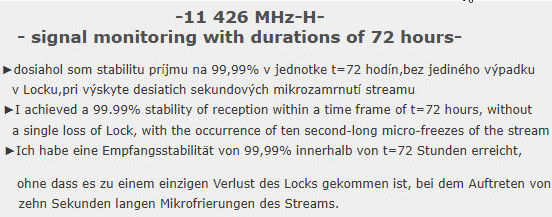

►porovnanie aktuálneho času 9:30 dňa 18.2.2025 s dátumom a časom posledného zamrznutia streamu 17.2.2025 o 9:06:47 dokazuje že som v jednotke monitorongu t=24 hodín naozaj dosiahol stabilitu príjmu na 100% bez jediného zamrznutia,alebo výpadku v Locku
►The comparison of the current time 9:30 on February 18, 2025, with the date and time of the last stream freeze on February 17, 2025, at 9:06:47,proves that I truly achieved a 100% reception stability within the monitoring period of t=24 hours, without a single freeze or loss of Lock.
►Der Vergleich der aktuellen Uhrzeit 9:30 am 18. Februar 2025 mit dem Datum und der Uhrzeit des letzten Stream-Frierens am 17. Februar 2025 um 9:06:47 beweist, dass ich tatsächlich eine Empfangsstabilität von 100% innerhalb der Monitoring-Zeit von t=24 Stunden erreicht habe, ohne ein einziges Einfrieren oder einen Verlust des Locks.
72H : A-B-C-D-E-F-_6 sections or points during the monitoring process
►A-B-C-D-E-F-G... sú momenty v ktorých replikujem alebo vkladám nové a aktualizované dáta z mnou vytvoreného signálneho modelu do anténneho systému,ktoré budú platné v nasledovnom časovom úseku typicky 4-6 hodín.Správnosť týchto dát je okamžite verifikovaná vysokým rastom signálnej kvality,konkrétne pre toto vlnenie od 0,4 do 2,3 dB
►Moments in which I replicate or insert new and updated data from the signal model,I created,into the antenna system, which will be valid in the following time period typically 4-6 hours. The accuracy of this data is immediately verified by a significant increase in signal quality, specifically for this wave from 0,4 to 2,3 dB.
►Momente,in denen ich neue und aktualisierte Daten aus dem von mir erstellten Signalmuster in das Antennensystem repliziere oder einfüge, die im folgenden Zeitraum typischerweise 4-6 Stunden gültig sein werden. Die Richtigkeit dieser Daten wird sofort durch einen hohen Anstieg der Signalqualität verifiziert, konkret für diese Welle von 0,4 bis 2,3 dB.
►Detail on 6 sections or points during the monitoring process where I update data, whose accuracy and validity are immediately verified by a sudden increase in quality.
►Synchronous Nanocorrections : 6x in 72h
►Detail na okamžitý rast kvality a kvantifikácia miery vzostupu signálnej rezervy v jednotkách decibelov
►Detail on the instantaneous growth of quality and quantification of the increase in signal reserve in decibel units.
►Detail zum sofortigen Anstieg der Qualität und zur Quantifizierung des Anstiegs der Signalreserve in Dezibel-Einheiten.
-A- -B- -C-
16.2.2025 - 00:45:22 CET 16.2.2025 - 13:08:40 CET 17.2.2025 - 00:44:13 CET
SNR status : +1,7 dB SNR status : +0,5 dB SNR status : +2,3 dB_5,2>7,5 dB
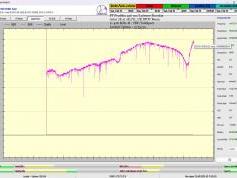

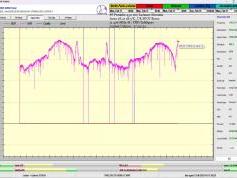
-D- -E- -F-
17.2.2025 - 07:53:03 CET 17.2.2025 - 18:09:46 CET 18.2.2025 - 00:44:40 CET
SNR status : +1,8 dB SNR status : +0,9 dB SNR status : +2,0 dB_5,9>7,9 dB



►►Astra 2E at 28.5°E-UK Spot Beam : Beacon frequency / TT&C
Astra 2E : TT&C > f=11 707.50 MHz_V
Astra 2E : TT&C > 12 493,000 MHz_H
►►Astra 2E at 28.5°E-UK Spot Beam: Continuous signal monitoring / Nepretržitý signálny monitoring
> 2, Monitoring of the frequency f=11 426 MHz_H_TRP/TalkSport <
> Transmision parameters : DVB-S _ QPSK _ SR=27500 _ FEC=2/3 <
<TSA-OK-online scan : 18.2.2025 o 20:00 CET_Lučenec/Slovakia >

►Klasifikácia dosiahnutých výsledkov na f=11 426 MHz_H : Výsledky signálneho monitoringu v jednotkách t=24 a t=72 hodín týmto nespochybnitelne verifikujú že som dosiahol stabilitu príjmu na 100% bez jediného výpadku v Locku a bez jediného zamrznutia streamu len v jednotke monitoringu t=24 hodín v meste Lučenec na juhu stredného Slovenska.V jednotke t=72 hodín som dosiahol stabilitu príjmu na 99,99%,kde sa z celkovo monitorovaných 259 200+ sekúnd vyskytlo mikrozamrznutie streamu celkovo len počas desiatich sekúnd , ovšem bez jediného výpadku v Locku nosnej za jednotku t=72 hodín,pretože návrat z mikrozamrznutia
streamu do kontinuity priebehu Locku bol okamžitý v každom bode výskytu a opakovania (o čom by vypovedal prípadný výskyt červenej plochy v signálnom monitoringu čo sa dokázateľne nestalo ani jeden krát za 72 hodín).
►EN_Classification of achieved results at f=11 426 MHz_H: The results of signal monitoring over time units t=24 and t=72 hours irrefutably verify that I have achieved 100% reception stability without a single loss of lock or stream freeze in the t=24-hour monitoring unit in the city of Lučenec, located in the south of central Slovakia. In the t=72-hour monitoring unit, I achieved a reception stability of 99.99%, where out of a total of 259,200+ monitored seconds, micro-freezing of the stream occurred for only ten seconds in total. However, there was not a single loss of lock during the t=72-hour period, as the recovery from micro-freezing to lock continuity was instantaneous at every occurrence and repetition. This is further confirmed by the absence of any red areas in the signal monitoring data, which demonstrably never appeared even once over the 72-hour period.
►DE_Die Ergebnisse der Signalüberwachung über die Zeiteinheiten t=24 und t=72 Stunden verifizieren zweifelsfrei, dass ich eine Empfangsstabilität von 100% ohne einzigen Lock-Verlust oder Stream-Freeze in der Überwachungseinheit t=24 Stunden in der Stadt Lučenec im Süden der Mittelslowakei erreicht habe. In der Überwachungseinheit t=72 Stunden habe ich eine Empfangsstabilität von 99,99% erzielt, wobei von insgesamt über 259.200 überwachten Sekunden Mikro-Freezing des Streams insgesamt nur für zehn Sekunden auftrat. Jedoch gab es während der gesamten t=72-Stunden-Periode keinen einzigen Lock-Verlust, da die Wiederherstellung aus dem Mikro-Freezing in die Lock-Kontinuität in jedem Auftreten und jeder Wiederholung sofort erfolgte. Dies wird zusätzlich durch das Fehlen jeglicher roter Bereiche in den Signalüberwachungsdaten bestätigt, die nachweislich während der gesamten 72 Stunden kein einziges Mal auftraten.
►Typická,a v závislosti od poveternostných podmienok,takmer každodenne meratelná špička kvality dosiahnutá v monitorovanom období od 15.2.2025 do 24.2.2025 :
> Typical and daily peak of quality under significantly non-degrading weather conditions on the signal path <
>Typische und tägliche Spitzenqualität unter signifikant nicht degradierenden Wetterbedingungen auf dem Signalweg.<
TBS 5925+EBSpro/CrazyScan : SNR=7,8-7,9 dB (Margin: 3,4-3,5 dB)
Octagon SF 4008 : SNR=7,5-7,8 dB (Margin: 3-3,5 dB)
Televes H60 : MER=7,8-8,0 dB (Margin: 3+ dB)
►Analýza spektra a kvality a meranie C/N,Pwr... s Televes H60+Metek HD : 11 426 MHz_H - TRP/TalkSport
f=11 426 MHz_H : SNR=7,5-7,8 dB (normal peak quality_E2/Open ATV 7.1) 
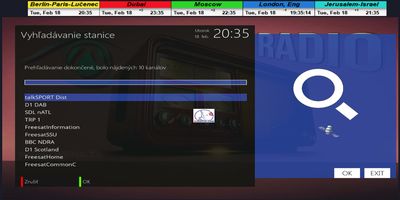
DOKAZOVANIE v celkovej kvantite monitoringu t=72 hodín
PROVING > Astra 2E at 28,5°E _f=11 426 MHz_H : TRP/TalkSport
Nepretržitý monitoring signálnych parametrov v jednotke t=72 hodín
Continuous monitoring of signal parameters in unit t=72 hours
►Deň záznamu monitoringu : od 15.2.2025 do 18.2.2025
Astra 2E at 28.5°E-footprint : UK Spot Beam
Place of sat.reception in Central Europe _ Geografischer Punkt des Satellitenempfangs in Mitteleuropa
Lučenec/Slovakia : 48°19′53″ s. š., 19°40′15″ v. d.
the geographical point of satellite reception is not located on the footprint map
der geografische Punkt des Satellitenempfangs ist nicht auf der Karte verzeichnet
source : SES Astra

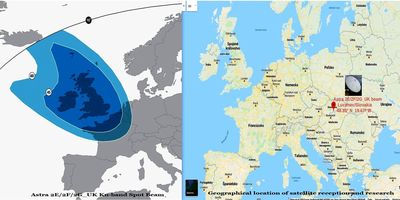
►Stav atmosféry : na základe meteogramov zo zdrojov shmu.sk môžem potvrdiť že počas výkonu signálneho monitoringu prevládala
v Lučenci jasná obloha bez dažďových,alebo snehových prehánok
TBS 5925+EBSpro >>> SNR peak=7,9 dB
od 15.2.2025 do 18.2.2025
►KOMPLEXNÝ POHĽAD zahrňujúci kvalitu Q v jednotke-% , úroveň výkonu v jednotke dBm , kvalitu SNR v bezrozmernej jednotke dB , chybovosť BER ...
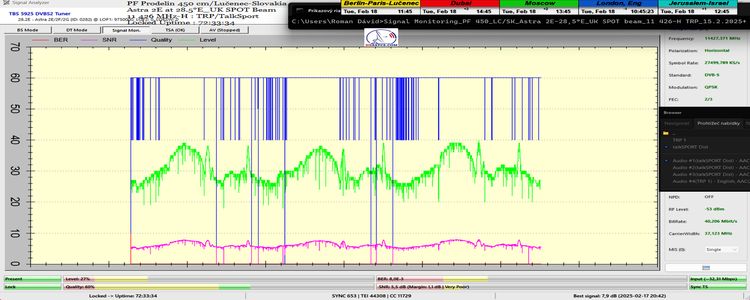
►DETAILNÝ POHĽAD zameraný na kvalitu príjmu a okamžité zmeny odvodené od jednotky merania SNR v trvaní 72 hodín

►Detailná analýza vývoja zmien kvality SNR s časovým kódom počas celého monitorovaného úseku 72 hodín v online video ukážke,
ktorá vylučuje pochybnosti všetkého druhu o reálnosti dosiahnutých úrovní kvality,poprípade akékoľvek dodatočné manipulácie
-okamžitá kvalita osciluje okolo: SNR=5,5 dB -
-okamžitá kvalita osciluje okolo: SNR=7,0 dB -
►+ 72 hodín_Priebežný stav v signálnom monitoringu dňa 18.2.2025 a online video ukážky
-okamžitá kvalita osciluje okolo: SNR=5,0 dB -

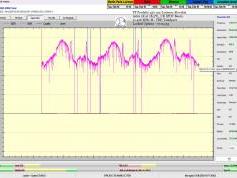

►►Astra 2E-2F-2G at 28.5°E-UK Spot Beam : copyright : Research project

